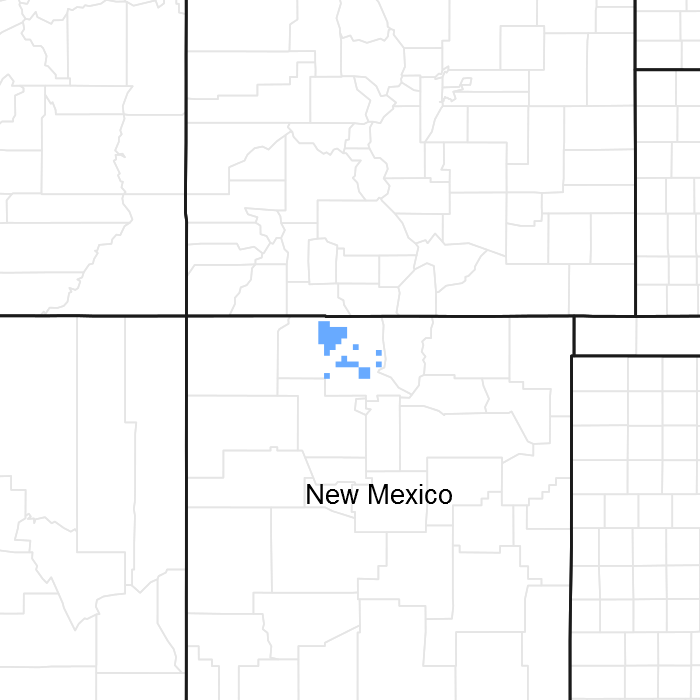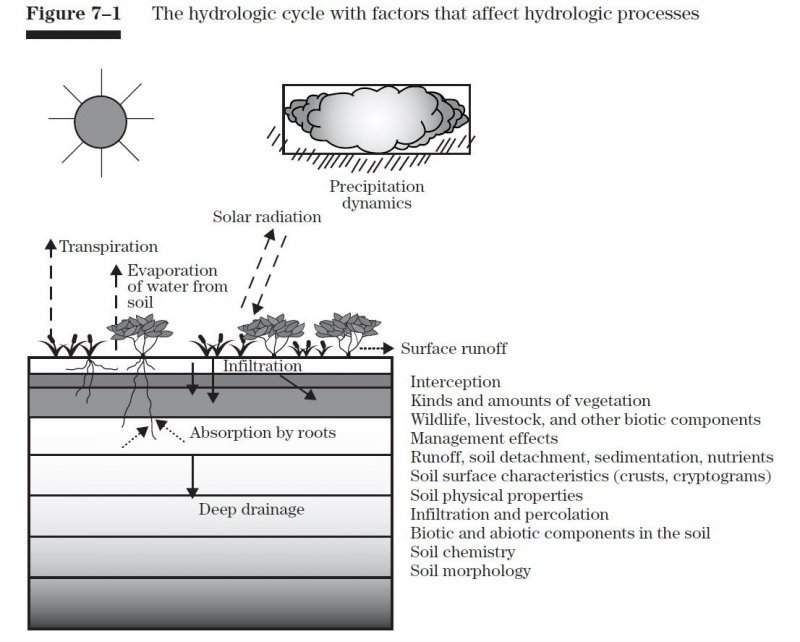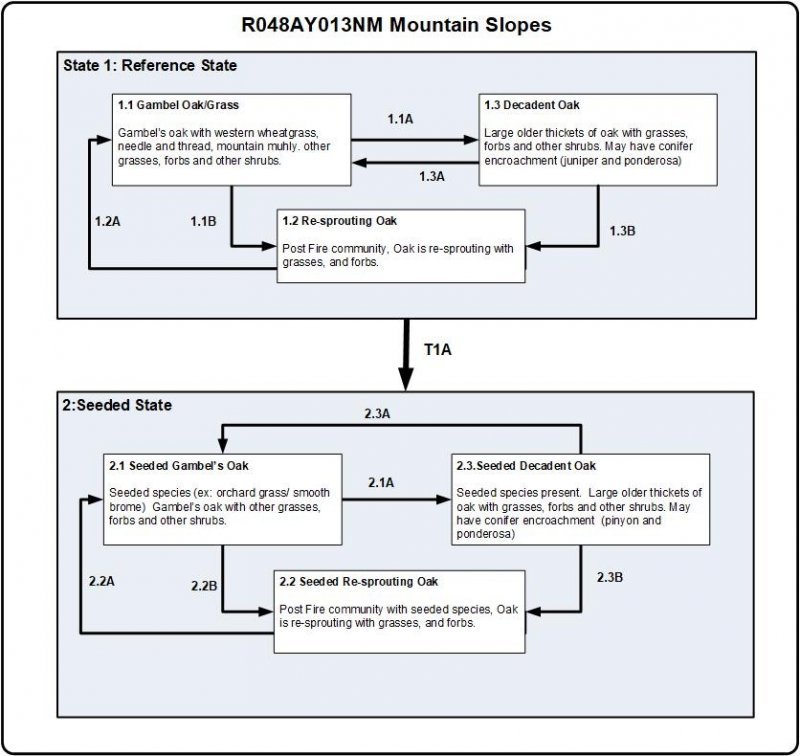
Natural Resources
Conservation Service
Ecological site R048AY013NM
Mountain Slopes
Last updated: 4/03/2025
Accessed: 12/19/2025
General information
Provisional. A provisional ecological site description has undergone quality control and quality assurance review. It contains a working state and transition model and enough information to identify the ecological site.

Figure 1. Mapped extent
Areas shown in blue indicate the maximum mapped extent of this ecological site. Other ecological sites likely occur within the highlighted areas. It is also possible for this ecological site to occur outside of highlighted areas if detailed soil survey has not been completed or recently updated.
MLRA notes
Major Land Resource Area (MLRA): 048A–Southern Rocky Mountains
This area is in Colorado (76 percent), New Mexico (11 percent), Utah (8 percent), and Wyoming (5 percent). It makes up about 45,920 square miles (119,000 square kilometers). The towns Jemez Springs, Los Alamos, Red River and Eagle Nest, New Mexico, are in this MLRA. This MLRA has numerous national forests, the Carson National Forest and part of the Santa Fe National Forest in New Mexico. The Jemez, Picuris, Santa Clara, and Taos Indian Reservations are in this MLRA. Most of this area is in the Southern Rocky Mountains Province of the Rocky Mountain System. Small parts of the southwest corner and some isolated areas farther west are in the Canyon Lands Section of the same province and division. The Southern Rocky Mountains consist primarily of two belts of strongly sloping to precipitous mountain ranges trending north to south. Several basins, or parks, are between the belts. The ranges include the Sangre de Cristo Mountains, Jemez Mountains, and Tusas Mountains. Elevation typically ranges from 6,500 to 13,167 feet (1,980 to 1,039 meters) in this area. The Rio Grande is a National Wild and Scenic River in northern New Mexico, which is in the southern part of this MLRA.
The mountains in this area were formed mainly by crustal uplifts during the late Cretaceous and early Tertiary periods. The rocks exposed in the mountains are mostly Precambrian igneous and metamorphic rocks, which in many places are flanked by steeply dipping Mesozoic sedimentary rocks. Younger igneous rocks, primarily basalt and andesitic lava flows, tuffs, breccias, and conglomerates, are throughout this area. Representative formations in this area are the Silver Plume and Pikes Peak granites, San Juan Volcanics, and Mancos Shale. Many of the highest mountain ranges were reshaped by glaciation during the Pleistocene. Alluvial fans at the base of the mountains are recharge zones for local basin and valley fill aquifers. They also are important sources of sand and gravel.
The dominant soil orders in this MLRA are Mollisols, Alfisols, Inceptisols, and Entisols. The soils in the area dominantly have a frigid or cryic soil temperature regime and an ustic or udic soil moisture regime. Mineralogy is typically mixed, smectitic, or paramicaceous. In areas with granite, gneiss, and schist bedrock, Glossocryalfs (Seitz, Granile, and Leadville series) and Haplocryolls (Rogert series) formed in colluvium on mountain slopes. Dystrocryepts (Leighcan and Mummy series) formed on mountain slopes and summits at the higher elevations. In areas of andesite and rhyolite bedrock, Dystrocryepts (Endlich and Whitecross series) formed in colluvium on mountain slopes. In areas of sedimentary bedrock, Haplustolls (Towave series) formed on mountain slopes at low elevations and with low precipitation. Haplocryolls (Lamphier and Razorba series), Argicryolls (Cochetopa series), and Haplocryalfs (Needleton series) formed in colluvium on mountain slopes at high elevations.
LRU notes
This site is part of the RM-2 sub-resource area. This site is found on the west side of Sangre de Cristo mountains, Tusas Mountains (southern San Juan mountains) and Jemez Mountains.
Classification relationships
This ecological site is correlated to soil components at the Major Land Resource Area (MLRA) level which is further described in USDA AgHandbook 296.
Ecological site concept
This site occurs on valley sides and hills ranging from relatively uniform, long slopes to short and choppy. Exposure is usually southern and/or western, which creates a relatively droughty site. Slopes range from 15 to 45 percent. Elevation ranges from 7,200 to 8,600 feet above sea level.
The soils are generally moderately deep to deep over interbedded shale and sandstone parent materials. Surface textures is usually a loam. Subsoils range from sandy clay loam, clay loam to clay.
This ecological site used to have the ID number of R048BY006NM in RM-2 subresource area in 1982.
Associated sites
| R048AY012NM |
Mountain Loam Dry This site occurs on gently sloping to moderately rolling uplands below or ranging into the ponderosa pine-Douglas fir woodlands. It may occur on open parks within the true woodlands. Slopes range from 1 to 20 percent. Elevation ranges from 7,200 to 9,200 feet above sea level. The soils are deep. Surface textures are loam or silt loam with subsoils varying from gravelly loam. very gravelly sandy clay loam, extremely cobbly clay loam. clay loam, or loam. Permeability is moderate slow to moderately rapid. This ecological site used to have the ID number of R048BY004NM in RM-2 subresource area in 1982. |
|---|---|
| F048AY925CO |
Ponderosa Pine Forest This site occurs on hillsides, mountain-slopes, mesas, structural benches and cuestas. Slopes are 3 to 30%. Soils are moderately deep to very deep (20 to 60+ inches). Soils are derived from slope alluvium from sandstone and/or shale, colluvium from sandstone and/or shale, or residuum from sandstone and shale. Soil surface texture is a loam, clay loam, sandy loam, fine sandy loam, very stony loam, cobbly sandy loam, or very boulder sandy loam with fine textured subsurface. It is a Ponderosa Pine - Muttongrass – squirreltail community. It has a typic ustic moisture regime. The effective precipitation ranges from 16 to 20 inches. |
Similar sites
| R048AY008NM |
Mountain Brush This site is located on the sides of basalt-capped mesas and escarpments of sandstone, basalt, shale and limestone. This site is formed on the upland leading away from vertical basalt escarpments and basalt-capped mesas. They are formed from a variety of materials derived from sandstone, basalt, shale and limestone. Rock outcrop is common and may occupy from 15 percent to 50 percent of the area. Slopes range from 5 to 25 percent. The exposure is mainly to the east, south and west. However, this site may occur on the drier north-facing slopes. North and east-facing slopes are generally more productive and tend to grow more woody vegetation. Elevation ranges from 7,500 to 9,000 feet above sea level. The soils on this site are shallow, well drained over sandstone, shale, basalt and limestone. Rock outcrops are common and occupy the nearly vertical basalt escarpments, ridges and benches of exposed sandstone, limestone and shale. Rubbleland occurs at the base of the basalt escarpments. The surface textures is usually clay loam and the subsoils are clay loam and clayey shale. The surface runoff is medium too rapid and the erosion hazard is severe. Effective rooting depth is from 12 to 20 inches. This site occurs in the RM-1 subresource area. |
|---|---|
| R048AY238CO |
Brushy Loam This site occurs on hills, mountains, complex landslides, and benches. Slopes is between 3 to 35%. Soils are moderately deep to deep (20 to 60+ inches), soils derived from colluvium, residuum, slope alluvium and alluvium from sandstone and shale. Soil surface texture is loam or clay loam with fine-textured subsurface. It is a Gambel’s oak – slender wheatgrass community. It has a typic ustic moisture regime. The effective precipitation ranges from 16 to 20 inches. |
Table 1. Dominant plant species
| Tree |
Not specified |
|---|---|
| Shrub |
(1) Quercus gambelii |
| Herbaceous |
(1) Pascopyrum smithii |
Click on box and path labels to scroll to the respective text.


